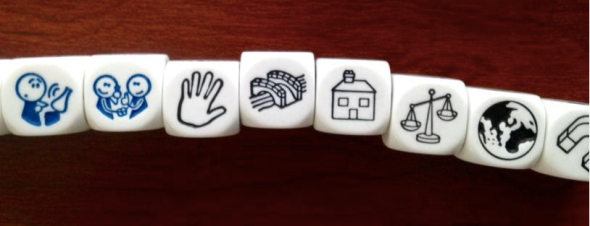Are you looking for a simple way to liven up your retrospectives? In my coaching engagements, I often encounter teams that are having ineffective retrospectives because they always take the same approach to framing the discussion. Using the same format for every retrospective preordains a very similar conversation each time, and it won’t take long for team members to start grumbling that the retrospectives aren’t working for them, creating a Doom Loop of disengagement.
I’ve had surprising successes dropping a handful of Rory’s Story Cubes on the table and suggesting “Hey, maybe we can use these to have a team conversation?”. Story Cubes share some of the magical properties of using LEGO Serious Play to spark a serious conversation: they’re fun, they’re tactile, and they’re easy to use. More introverted team members who might be intimidated by being asked to do improv don’t seem to notice when there are Story Cubes involved. By breathing a spirit of playfulness into the conversation, and engaging fingers as well as tongues, the people at the table will share ideas that haven’t surfaced in previous retrospectives. It’s also a great technique for dragging the conversation out of the rut of endless griping that some retrospectives seem to fall into.
Story Cubes are easy to use, and can be adapted to a number of different purposes. The Original set is enough to work with, though including another set such as the Actions (particularly useful for Retros) or some of new Mix-ins can help inspire greater creativity.
Here are some ways that you might incorporate Story Cubese into your next retrospective:
- Check In: One person rolls, then each participant picks one cube and offers an associated word to complete a simple check-in statement, such as “The last sprint was great because…” or “Today, I’m feeling like…”
- Data Gathering: Use the cubes to inspire the story of the retrospective. Dana Pylayava suggests: “Everyone picks 1 image as his view of last sprint. Speaking in turns, team builds the shared story in 9 cubes”. There really are no rules here: have each person choose one cube or a few; people can roll again if they come up dry in continuing the story. Or have each person roll and then use all the cubes to tell a short individual story about their experience of the sprint.
- Gathering insights: To mix things up and really boost ideation, try combining Story Cubes with brain-writing to encourage everyone to generate ideas about why things are the way they are. Roll the cubes, have each participant silently write as many ideas as possible on individual post-its using the images on the cubes as inspiration in identifying patterns, themes, and connections. Roll the cubes again and repeat. Then use silent affinity grouping to assemble the big picture before starting to talk about what’s been revealed.
- Deciding what to do: This is where the Actions or Voyages cubes might be particularly useful to draw out creative ideas about “What is the thing we should do differently next sprint to be more successful?”. Use the cubes to brainstorm as many ideas as possible about what types of actions will get the team to the desired destination (and then make a collective decision about which one to focus on, of course!).
- Closing the retrospective: Similar to the Check In, have participants select an image from a cube to help them complete a closing statement, such as “Our next sprint will be better because….”
While I’ve offered ideas for how to use Story Cubes for any phase of a retrospective, I wouldn’t recommend using them for the entire thing. Choose one or two of the phases and combine using Story Cubes with other techniques for soliciting input – this is a great way to start especially if your team is unaccustomed to using playful props to do serious work.
Some other ideas for how to use Story Cubes in retros:
- http://www.agilecafe.org/story-cubes-build-your-story-with-cubes-in-the-next-retrospective/
- http://blog.scrum.org/rory-cubes-for-sprint-retrospective/
I would love to hear from you about how you’re using them – leave me a comment!
Where to find them?: Rory’s Story Cubes are available at many toy stores, via Amazon, or directly from Rory’s Story Cubes. And no, I don’t get any promotional perks for being a Story Cubes fangirl. I just really like their product.
